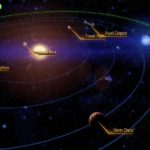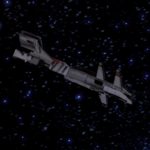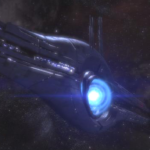System Specs:
- Stellar Mass: 0.783 Sol Masses
- Stellar Class: K
- Luminosity: N/A Sol
- Planets: 4
- Moons: 35
- Asteroid Belts: 0
- Asteroids: 0
- Objects: 2

It is home to a civilization or civilizations that were wiped out by some targeted cataclysm before the coming of the current Citadel races. The volus have even discovered remnants of a uranium mining station that’s about 50,000 years old, or dating roughly from the time of the Protheans. Consequently, the system rates moderate to rich in resources and can also be mined for element zero.
A Galactic News Network announcer pronounced the name of the system as ‘shay chah’ (ʃeɪ ʧɑː).
–
Planets Directory:
- Zada Ban
- Aphras
- Tosal Nym
- fuel depot
- Vem Osca
- Mass Relay
–
Zada Ban:

- Orbital Distance: 0.7 AU
- Orbital Period: 0.9 Earth-years
- Keplerian Ratio: 0.423
- Radius: 7,594 km
- Day Length: 70.0 Earth-hours
- Atmospheric Pressure: 0.0 atm
- Surface Temp: 94 °C
- Surface Gravity: 1.5 g
- Mass: 2.111 Earth-masses
- Colony: Volus, Dolo Station (largest; no capital), founded 2154, population 22,500 (in orbital stations)
Zada Ban is a large, dense planet named for a volus god of punishment. Its crust is rich in uranium, eroded by winds to create large radioactive dust storms across its surface. The volus of Talis Fia have explored the planet thoroughly with space probes and telepresent robo-mining machines, and discovered they are not the first to exploit the planet. Plastics from a mining station approximately 50,000 years old can be found near the planet’s equator. Curiously, the mines nearby were not tapped out of uranium ore; they were instead abandoned at the height of their operation.
–
Aphras:

- Orbital Distance: 1.4 AU
- Orbital Period: 2.0 Earth-years
- Keplerian Ratio: 0.686
- Radius: 4,530 km
- Day Length: 31.3 Earth-hours
- Atmospheric Pressure: 2.32 atm
- Surface Temp: 33 °C
- Surface Gravity: 0.7 g
- Mass: 0.35 Earth-masses
A unique discovery, Aphras is a “heavenly twin,” a planet in a star system that has not one but two worlds of sufficient mass to retain an [sic] nitrogen-oxygen atmosphere within the habitable life zone of its parent star. Fossil evidence shows abundant vertebrates and evidence of a sapient terrestrial avian species in its Bronze Age.
However, the only trace of contemporary life on the planet is that of single-celled organisms in its seas. All else has suffered from an extinction event — a series of massive impacts that vaporized vast quantities of water and lofted dust into its atmosphere. Early theories that this event was a collision with a fragmenting asteroid have now been discounted — the impact craters were aimed directly at habitation centers.
–
Tosal Nym:

- Orbital Distance: 2.1 AU
- Orbital Period: 3.0 Earth-years
- Keplerian Ratio: 1.029
- Radius: 6,930 km
- Day Length: 19.8 Earth-hours
- Atmospheric Pressure: 1.86 atm
- Surface Temp: 18 °C
- Surface Gravity: 1.3 g
- Mass: 1.523 Earth-masses
The sister tragedy to the extinction event on Aphras, Tosal Nym was the rarest of jewels; a second garden planet within the same life zone as Aphras. Not as old as its sister planet, its fossil evidence indicates it was home to abundant invertebrate sea life.
However, similar craters to those on Aphras created a dust shroud that killed 99% of biota on the planet. The even spacing of the craters indicates a coordinated, simultaneous attack from points around the globe, rather than an asteroid collision or super-volcanic scenario.
–
Vem Osca:

- Orbital Distance: 4.6 AU
- Orbital Period: 9.9 Earth-years
- Keplerian Ratio: 0.993
- Radius: 64,826 km
- Day Length: 11.9 Earth-hours
- Atmospheric Pressure: N/A atm
- Surface Temp: N/A °C
- Surface Gravity: N/A g
- Mass: N/A Earth-masses
- Satellites: 35
A Jovian gas giant, Vem Osca (“weeping witness” in Iperian Volus) is a low-density hydrogen-helium planet with 35 moons. Later this year, 33 of the moons will be visible from the planet’s surface in a conjunction, an event that will be recorded by space probes from all over the galaxy.
–
–
video







